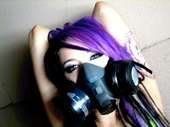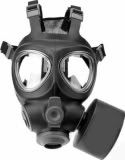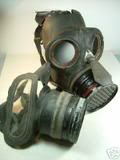Here are some information on gasmasks that I have stumbled across during my travels on the web. Enjoy.
Taken from Wikipedia
Gas Masks
A gas mask is a mask worn on the face/head to protect the body from airborne pollutants and toxic materials. The mask forms a sealed cover over the nose and mouth, but may also cover the eyes and other vulnerable soft tissues of the face. Some gas masks are also respirators, though the word gas mask is often used to refer to military equipment (e.g. Field Protective Mask, etc.).
Airborne toxic materials may be gaseous (for example the chlorine gas used in World War I or particulate (such as many biological agents developed for weapons such as bacteria, viruses and toxins). Many gas masks include protection from both types.
Gas masks used in World War I were made as a result of poison gas attacks that took the Allies in the trenches on the Western Front by surprise. Early gas masks were crude as would be expected as no one had thought that poison gas would ever be used in warfare as the mere thought seemed too shocking
Principles of construction
Unlike other breathing devices, gas masks do not require the user to carry an air supply as in the use of scuba gear. However, this means that the wearer depends on the air in the atmosphere, the same medium of the toxic materials. Thus, the mask must remove them and relay clean air to the wearer. There are three main ways of achieving this: filtration, absorption and adsorption, and reaction and exchange.
Absorption is the process of being drawn into a (usually larger) body, or substrate, and adsorption is the process of deposition upon a surface. This can be used to remove both particulate and gaseous hazards. Although some form of reaction may take place, it is not necessary; the method may work by attractive charges (for example, if the target particles are positively charged, use a negatively charged substrate). Examples of substrates include activated carbon, and zeolites. This effect can be very simple and highly effective, for example using a damp cloth to cover the mouth and nose whilst escaping a fire. While this method can be effective at trapping particulates produced by combustion, it does not filter out harmful gases which may be toxic or which displace the oxygen required for survival.
History and development of the gas mask
A primitive respirator to be used by miners was introduced by Alexander von Humboldt already in 1799, when he worked as a mining engineer in
In the early days of World War I, the Canadian Army made field expedient gas masks to protect themselves from the deadly chlorine gas used by the German Army. They would urinate on rags and hold them to their faces.
One such design began as a "Safety Hood and Smoke Protector" invented by African American inventor, Garrett A. Morgan in 1912, and patented in 1914. It was a simple device, consisting of a cotton hood with two hoses which hung down to the floor, allowing the wearer to breathe the safer air found there. In addition, moist sponges were inserted at the end of the hoses in order to better filter the air. Morgan won acclaim for his device when in 1916 he, his brother, and two other volunteers used his device to rescue numerous men from the gas and smoke-filled tunnels beneath Lake Erie in the
Due to the run on raw materials during the war, businesses were in increasing competition to find alternates to any material needed for military use. In this case the cotton used in the gas masks, one such solution was the forerunner of Kleenex, called Cellucotton.
Dr. Cluny MacPherson of The Royal Newfoundland Regiment, while serving in Gallipoli in 1915, where he acted as an advisor on poisonous gas, used a helmet taken from a captured prisoner to fashion a canvas hood with transparent eyepieces that was treated with chlorine-absorbing chemicals. The MacPherson respirator gas mask was the first general issue gas countermeasure to be used by the British Army.
The British PH helmet was issued in 1915 and the first box respirator in 1916
But the inventor of the first effective coal gas mask was Russian scientist Nikolay Dimitrievich Zelinskiy in World War I (in 1915) against German gas attacks. In 1916 his gas masks were accepted on arms of the countries of Triple Entente. Zelinskiy gas mask is most popular in the world.
The British had developed and put into use the canister gas mask by the end of the war. This had a mask connected to a tin can containing the absorbent materials by a hose.
Gas masks development since has mirrored the development of chemical agents in warfare, filling the need to protect against ever more deadly threats, biological weapons, and radioactive dust in the nuclear era. However, where agents that cause harm through contact or penetration of the skin occurs, such as blister agent or nerve agent, a gas mask alone is not sufficient protection, and full protective clothing must be worn in addition, to protect contact from the atmosphere. For reasons of civil defense and personal protection, individuals often purchase gas masks in the belief that they prevent against the harmful effects of an attack with nuclear, biological, or chemical (NBC) agents; this is not the case, as gas masks protect only against respiratory absorption. Whilst most military gas masks are designed to be capable of protection against spectrum of NBC agents, they can be coupled with filter canisters that are proof against those agents (heavier) or just against riot control agents and smoke (lighter, and often used for training purposes); likewise there are lightweight masks solely for use in riot control agents and not for NBC situations.
Although thorough training and the availability of gas masks and other protective equipment can render the casualty-causing effects of an attack by chemical agents nullified, troops who are forced to operate in full protective gear are less efficient in completing their given tasks, tire easily, and may be affected psychologically by the threat of attack by these weapons. During the Cold War era, it was seen as inevitable that there would be a constant NBC threat on the battlefield, and thus troops needed protection in which they could remain fully functional; thus protective gear, and especially gas masks have evolved to incorporate welcomed innovations in terms of increasing user-comfort, and in compatibility with other equipment (from drinking devices to artificial respiration tubes, to communications systems etc). The gas mask has thus now arrived at a 'fourth generation' of development.
Here are some other websites that I have found that specialise in gas masks
Last but not least here are some images for your viewing pleasure. Images taken from photobucket.com






No comments:
Post a Comment